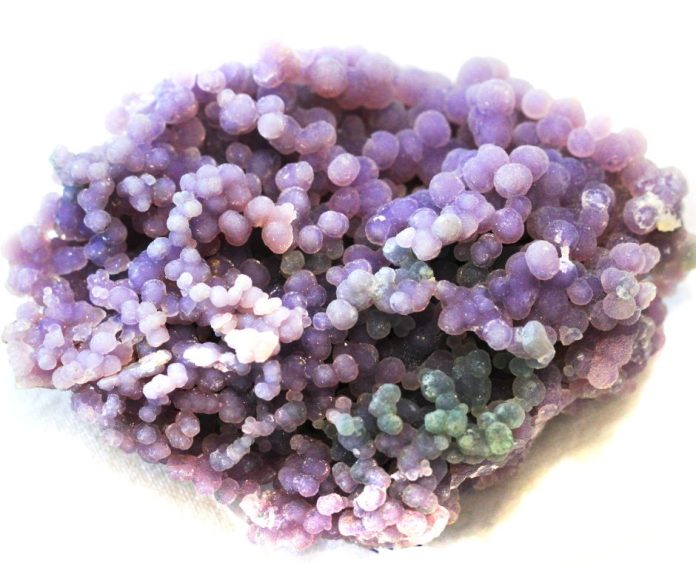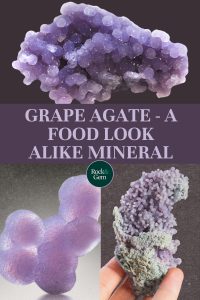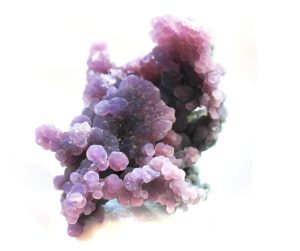
Grape agate may resemble tasty lunchtime grapes, but it is not. This food look-alike is a mineral that has a cool factor that can’t be denied.
What’s in a Name?
Rock? Food? What’s up with the foodie name? Marketing! It’s kind of like a famous line from the classic movie, Spaceballs. “Merchandising, merchandising, where the real money from the movie is made.”

Grape agate is a fun marketing name for a fascinating mineral – botryoidal purple chalcedony. Plus, grape agate is easy to say, remember and visualize.
Definitions
Botryoidal – In Ancient Greek, this term literally means “bunch of grapes.” It refers to a mineral habit that is made of rounded segments. This habit is found in other minerals such as hematite, malachite, chalcedony, goethite, fluorite and smithsonite.
Chalcedony – The general term, chalcedony, refers to varieties of quartz where microcrystalline and cryptocrystalline crystals intertwine and grow together. There are many varieties of chalcedony in different colors and patterns. Chalcedony’s name is said to come from the Greek port of Chalcedon.
Agate Identification Facts
Grape agate appears as small, round nodules around two to eight millimeters across. Its colors can vary, ranging from translucent to a deep purple or lavender hue. It can also be white, gray, blue or green. (Maybe unripe grapes or the green kind from the store?) These vibrant colors are caused by traces of minerals, such as manganese and iron, that were present during the formation process.
One interesting feature of grape agate is its texture. The individual crystals that make up the grape-like clusters are usually small and spherical. They can have a bumpy or drusy surface, giving them a rough yet sparkling appearance.
When examining grape agate, you may notice tiny hollows or vugs on the surface. These are remnants of gas bubbles that were present when the crystals formed.
Grape Agate: A New & Rare Mineral
 This is a newcomer appearing on the “rock” scene around 2016. Grape agate is found in only a few places on Earth — Indonesia and west of the Green River in Utah. It is a popular mineral for use as a display piece or in jewelry.
This is a newcomer appearing on the “rock” scene around 2016. Grape agate is found in only a few places on Earth — Indonesia and west of the Green River in Utah. It is a popular mineral for use as a display piece or in jewelry.
Beware of Mineral Dupes
Real grape agate is highly sought after and can be pricey depending on quality, especially the color and size. The deeper and bolder the color, the higher the price. And the bigger, the better. Beware though, some grape agate is dyed to achieve a more desirable color.
Caring for Grape Agate
Grape agate has a Mohs hardness of around 6.5 to 7. With individual “grapes” sticking out, they can get jostled and come loose or fall off completely. Handle it with care and avoid contact with rough surfaces. When left in the sun, grape agate can lose its color so avoid setting it in a sunny spot.
This Rock & Gem Kids story previously appeared in Rock & Gem magazine. Click here to subscribe. Story by Pam Freeman.















